39 conservation of mass lab
Conservation of Mass Inquiry Lab - Kesler Science The models are to help students visual conceptualize how the Law of Conservation of Mass shows the beginning mass (reactants) will equal the ending mass (products). At this point in the lab, students will be checked for understanding by answering questions about their findings. Here are a few that come with the lab: Conservation of mass lab - 1 Conservation of Mass_Essay1_Ex. 1 Results ... 5 Conservation of Mass_Essay5_Ex. 1 Law of Conservation of Mass EXPERIMENT 1: According to the law of conservation of mass, matter cannot be created nor destroyed. Do your results from this experiment agree with this law? 6 Conservation of Mass_Essay6_Ex. 2 Results Table EXPERIMENT 2: Record your lab results in the table below.
PDF Conservation of Mass Lab - Georgetown ISD express the law of conservation of mass is to say that the mass of all of the products equals the mass of all of the reactants.) 4. When a log burns, the resulting ash obviously has less mass than the unburned log did. Explain whether this loss of mass violates the law of conservation of mass. Data Table: Initial and Final Mass Part 1 Mass (g) 1.

Conservation of mass lab
Center of mass - Wikipedia In physics, the center of mass of a distribution of mass in space (sometimes referred to as the balance point) is the unique point where the weighted relative position of the distributed mass sums to zero. This is the point to which a force may be applied to cause a linear acceleration without an angular acceleration.Calculations in mechanics are often simplified when formulated … Lab Conservation of Mass, shortened - Google Docs 1.Using the balance, measure out 11g of calcium chloride (CaCl2) and add it to the plastic bag. 2. Mass 7g of sodium carbonate (NaCO3) to the bag, and shake gently to mix. 3. Determine the mass of the bag and its contents. Record this value in Data Table - Part II. 4. Investigation into Conservation of Mass Lab The law of conservation of mass was obeyed in this lab. The law of conservation of mass states that the mass of your initial substances (reactants) will be the same as the mass of the substances that you get after the reaction has occurred (products). 5 | P a g e 6. When the solutions were mixed, did a chemical change occur?
Conservation of mass lab. Law of Conservation of Mass Lab - DocsLib Repeat step 1, measure out 4g of baking soda. 6. Carefully transfer the baking soda to one corner of the plastic bag and seal with a twist tie. 7. Using a graduated cylinder, measure 40 mL of vinegar. Pour the vinegar in the upper part of the bag and seal the bag. 8. Place the bag in a beaker and measure the mass of the beaker, bag and reactants. Conservation_of_Mass_lab.docx - Conservation of Mass lab... - Course Hero Conservation of Mass lab Procedures 1. Find the mass of an empty Erlynmeyer Flask, test tube, and rubber stopper. Record the Results 2. Using a graduated cylinder, measure 20 mL of copper (II) sulfate and pour it in the Erlenmeyer flask. 3. Measure 10 mL of sodium hydroxide solution into the test tube. Mass spectrometry - Wikipedia Mass spectrometry (MS) is an analytical technique that is used to measure the mass-to-charge ratio of ions. The results are presented as a mass spectrum, a plot of intensity as a function of the mass-to-charge ratio. Mass spectrometry is used in many different fields and is applied to pure samples as well as complex mixtures. Conservation of mass - Wikipedia Formulation and examples. The law of conservation of mass can only be formulated in classical mechanics, in which the energy scales associated to an isolated system are much smaller than , where is the mass of a typical object in the system, measured in the frame of reference where the object is at rest, and is the speed of light.. The law can be formulated mathematically in the fields of ...
Conservation of Mass Experiments - Science Lessons That Rock Conservation of Mass Experiments The law of conservation of mass states that mass in a closed system will not change before and after a chemical reaction. Mass isn't created or destroyed, it just moves places. Seems simple enough, but this law can be difficult to demonstrate. It seems nearly impossible to get PERFECT data every time. Lab: Conservation of Mass Lab: Conservation of Mass. 1. What is the law of conservation of mass? 2. Why is it hard to prove the law when a gas is produced? The change in mass when magnesium burns - RSC Education 5.3.1 Chemical measurements, conservation of mass and quantitative interpretation of chemical equations. 5.3.1.3 Mass changes when a reactant or product is a gas. Some reactions may appear to involve a change in mass but this can usually be explained because a reactant or product is a gas and its mass has not been taken into account. Law Of Conservation Of Mass Lab Worksheet Answers Ans: According to law of conservation of mass: Mass of reactants = Mass of products. ∴ 10 gram of CaCO 3 = 3.8 grams of CO 2 + 6.2 grams of CaO. 10 grams of reactant = 10 grams of products. Hence, it is proved that the law of conservation of mass is followed by the above reaction.
CONSERVATION OF MASS LAB Science 6 The Law of Conservation of Mass states that mass in a closed system will remain constant (same). Matter can NOT be created or destroyed. Law of Conservation of Mass Lab - Google Docs Law of Conservation of Mass Lab Purpose: To attempt to verify & observe the Law of Conservation of Mass. Materials: balance 600 mL beaker 1 balloon weighing paper 2 liter soda bottle/cap (or... PDF Law of Conservation of Matter - Science Classroom Teacher Resources Conservation of Mass. 2. Given Alka-Seltzer and a flask, students design and conduct an experiment to prove the Law of Conservation of Mass. Key Question: When the substances are combined in a plastic bag, how can the law of conservation of mass be observed? Related Process TEKS: (1) Scientific processes. The student, for at least 40% of ... Empty string - Wikipedia Formal theory. Formally, a string is a finite, ordered sequence of characters such as letters, digits or spaces. The empty string is the special case where the sequence has length zero, so there are no symbols in the string.
Lab: Conservation of Mass Lab: Conservation of Mass This investigation is a lab where students find out if mass is created or destroyed in a closed system. Students will balance the chemical equation to re-enforce their findings. In this lab students will conduct an investigation to find out if substance either lose or gain mass after a chemical reaction takes place.
Law of Conservation of Mass Lab - Docest 1. Record the mass of the empty beaker. Pour about 15 mL of vinegar into the beaker. Record the mass of the beaker & vinegar. 2. Weigh out ~5 g of baking soda onto a piece of weighing paper. Record the exact mass of baking soda used. 3. Place the beaker/vinegar and the weighing paper/baking soda on the pan of the laboratory balance.
Home | MASS Design Group The Rwanda Institute for Conservation Agriculture (RICA) – projected to be the first climate positive university in the world – is designed to train Rwanda’s next generation of leaders in agriculture, while supporting national priorities for agricultural development. Conceived and funded by the Howard G. Buffett Foundation, and supported by the Government of Rwanda, …
High Country News – Know the West A nonprofit independent magazine of unblinking journalism that shines a light on all of the complexities of the West.
Center of mass - Wikipedia where m is the total mass of all the particles, p is the linear momentum, and L is the angular momentum. The law of conservation of momentum predicts that for any system not subjected to external forces the momentum of the system will remain constant, which means the center of mass will move with constant velocity. This applies for all systems ...
Law of Conservation of Mass Lab Law of Conservation of Mass Lab. Purpose: To attempt to verify & observe the Law of Conservation of Mass - In any chemical reaction, the total.
U.S. News: Breaking News Photos, & Videos on the United States - NBC News 16.02.2013 · Find the latest U.S. news stories, photos, and videos on NBCNews.com. Read breaking headlines covering politics, economics, pop culture, and more.
U.S. News | Latest National News, Videos & Photos - ABC News - ABC News 19.11.2022 · Get the latest breaking news across the U.S. on ABCNews.com
Learning Activity: Law of Conservation of Mass Lab LAP 3 - Law of Conservation of Mass Lab (the post-lab) The following are the handouts that students received during this activity: The Law of Conservation of Mass Instructions and Materials (here) The Modified Lab Report Write-Up (here) The Lab Report Checklist (here) The Lab Report Rubric (here)
CHM 151 : General Chemistry 1: Conservation of Mass: Lab Assignment ... CHM 151 : General Chemistry 1: Conservation of Mass: Lab Assignment Term 1 / 33 Experiment 1: What was the mass of the empty, open 150-mL Erlenmeyer flask? Note: The sizes of containers in the lab may vary. Select the closest answer. 185.000 g 94.000 g 34.000 g 50.000 g Click the card to flip 👆 Definition 1 / 33 94.000 g
Conservation of energy - Wikipedia Thus, conservation of energy (total, including material or rest energy), and conservation of mass (total, not just rest) are one (equivalent) law. In the 18th century, these had appeared as two ... From the point of view of modern general relativity, the lab environment can be well approximated by Minkowski spacetime, where energy is ...
Conservation Of Mass Lab - 1206 Words | Studymode We used two important laws of chemistry in this lab. Firstly, the Law of Conservation of Mass states that matter is neither created nor destroyed during a chemical reaction and the mass of a system should therefore remain constant during any chemical process. In other words, the mass of any one …show more content…
ZOOM - PBS Kids ZOOM is no longer available at pbskids.org ZOOM teacher resources are available on PBS LearningMedia. For more information, please contact the program producers:
Soil | Natural Resources Conservation Service - USDA The Regional Conservation Partnership Program (RCPP) is a partner-driven approach to conservation that funds solutions to natural resource challenges on agricultural land. Resources The technical resources and references NRCS provides uses science-based technology to aid conservation planning and benefit soil, water, air, plants, and animals ...
What Is the Law of Conservation of Mass? - ThoughtCo Oct 09, 2019 · Simply stated, the law of conservation of mass means matter cannot be created or destroyed, but it can change forms. In chemistry, the law is used to balance chemical equations. The number and type of atoms must be the same for both reactants and products.
Conservation of Mass Lab Report - Chem 1162 Conservation of Mass Lab ... The objective of the conservation of mass lab is to prove that matter cannot be created or destroyed, and that it only changes state. This is an important law in chemistry, as it helps us prove countless different properties during experiments, as it allows one to take the mass of products and figure out the exact mass of the products.
Conservation of Mass - Essential Chemistry Teacher Lab ... Students experimentally determine the amount of sodium bicarbonate in an antacid tablet based on the mass of carbon dioxide formed when the tablet reacts in water. Supports NGSS Performance Expectation HS-PS1-7: Use mathematical representations to support the claim that atoms, and therefore mass, are conserved during a chemical reaction.
PDF Lab: Conservation of Mass Lab: Conservation of Mass 1. What is the law of conservation of mass? 2. Why is it hard to prove the law when a gas is produced? 3. What is the difference between an "open" system & a "closed" system? Reaction #1: Baking Soda & Vinegar Materials: 2 be akr s,ln cv i god p t Part 1: Open System 1. Calibrate, or set the balance to 0. 2.
Conservation of mass | practical videos | 14–16 years Conservation of mass · 1. Measure out 20 cm3 of hydrochloric acid in a measuring cylinder. · 2. Place the 20 cm3 hydrochloric acid into a 250 cm3 conical flask.
Lab Report: Law of Conservation of Mass | PDF | Sodium Chloride ... Conclusion: Since, in both part 1 and 2, the mass of the reactants and the mass of the products was the same, therefore, according to the Law of Conservation of Mass, no mass can be gained or lost during a chemical reaction. Discussion: This lab was done to verify the Law of Conservation of Mass.
Law Of Conservation Of Mass Lab Teaching Resources | TPT Law of Conservation of Mass Lab. by. The Crafty Science Teacher. 5.0. (18) $2.00. PDF. This lab is an engage activity for introducing the Law of Conservation of Mass, integrating Science TEKS 8.5 D and 8.5 E. Students will measure the mass of two substances, baking soda and vinegar, before and after a chemical reaction.
Soil | Natural Resources Conservation Service - USDA The Regional Conservation Partnership Program (RCPP) is a partner-driven approach to conservation that funds solutions to natural resource challenges on agricultural land. Resources The technical resources and references NRCS provides uses science-based technology to aid conservation planning and benefit soil, water, air, plants, and animals for productive lands and …
Teaching Law of Conservation of Mass in Fifth Grade Now it's even harder to believe the law of conservation of mass." Baking Soda and Vinegar "But look at this," said Mr. Grow. "In this lab, kids compare the mass after a chemical change. The ingredients are simple: baking soda and vinegar. For the first part of the experiment, they use an open container.
Law of Conservation of Matter Lab: Teacher Notes Conservation of Mass. 2. Given Alka-Seltzer and a flask, students design and conduct an experiment to prove the Law of Conservation of Mass. The law of conservation of mass indicates that mass cannot be created nor destroyed. This means the total mass of reactants in a chemical reaction will equal the total mass of the products.
Conservation of mass - BBC Bitesize Learn about the conservation of mass in physical and chemical reactions in this guide for students aged 11 to 14 from BBC Bitesize.
Law of Conservation of Mass - Definition, Formula, Examples, Problem Ans: According to law of conservation of mass: Mass of reactants = Mass of products ∴ 10 gram of CaCO 3 = 3.8 grams of CO 2 + 6.2 grams of CaO 10 grams of reactant = 10 grams of products Hence, it is proved that the law of conservation of mass is followed by the above reaction. Frequently Asked Questions - FAQs
The law of conservation of mass - Todd Ramsey | TED-Ed Everything in our universe has mass — from the smallest atom to the largest star. But the amount of mass has remained constant throughout existence even during the birth and death of stars, planets and you. How can the universe grow while maintaining its mass? Todd Ramsey answers that question by unravelling the law of conservation of mass.
conservation of mass | physics | Britannica conservation of mass, principle that the mass of an object or collection of objects never changes, no matter how the constituent parts rearrange themselves. Mass has been viewed in physics in two compatible ways.
Conservation of Mass Lab. What Goes In Must Come Out. This is the law of conservation of mass - matter cannot be created nor destroyed it only changes forms. Balancing equations is where we want kids to visualize this concept. There are lots of great ways to make this more hands on. Create a balance Use different color beads and a table At the very least make a table.
What Is the Law of Conservation of Mass? - ThoughtCo 09.10.2019 · To clarify: An isolated system is one that does not interact with its surroundings. Therefore, the mass contained in that isolated system will remain constant, regardless of any transformations or chemical reactions that occur—while the result may be different than what you had in the beginning, there can't be any more or less mass than what you had prior to the …
Conservation of Mass Lab Report (1).docx - Conservation Of... Considering the law of conservation of mass, the mass for Part 1 should be the exact same due to the experiment being done in a closed assembly. This considered, the class had an average mass change of -0.045 grams which is of course not accurately representing the law of conservation of mass.
conservation of mass lab - TeachersPayTeachers Law of Conservation of Mass Lab. by. The Crafty Science Teacher. 5.0. (19) $2.00. PDF. This lab is an engage activity for introducing the Law of Conservation of Mass, integrating Science TEKS 8.5 D and 8.5 E. Students will measure the mass of two substances, baking soda and vinegar, before and after a chemical reaction.
Investigation into Conservation of Mass Lab The law of conservation of mass was obeyed in this lab. The law of conservation of mass states that the mass of your initial substances (reactants) will be the same as the mass of the substances that you get after the reaction has occurred (products). 5 | P a g e 6. When the solutions were mixed, did a chemical change occur?
Lab Conservation of Mass, shortened - Google Docs 1.Using the balance, measure out 11g of calcium chloride (CaCl2) and add it to the plastic bag. 2. Mass 7g of sodium carbonate (NaCO3) to the bag, and shake gently to mix. 3. Determine the mass of the bag and its contents. Record this value in Data Table - Part II. 4.
Center of mass - Wikipedia In physics, the center of mass of a distribution of mass in space (sometimes referred to as the balance point) is the unique point where the weighted relative position of the distributed mass sums to zero. This is the point to which a force may be applied to cause a linear acceleration without an angular acceleration.Calculations in mechanics are often simplified when formulated …


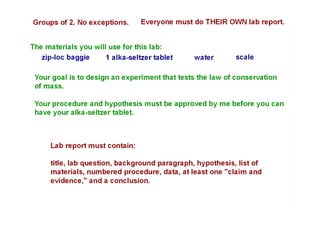
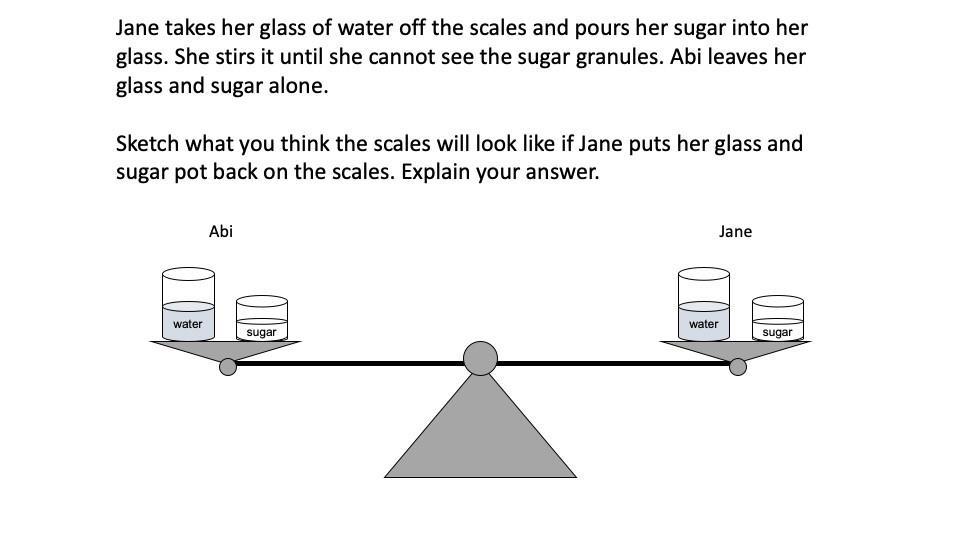









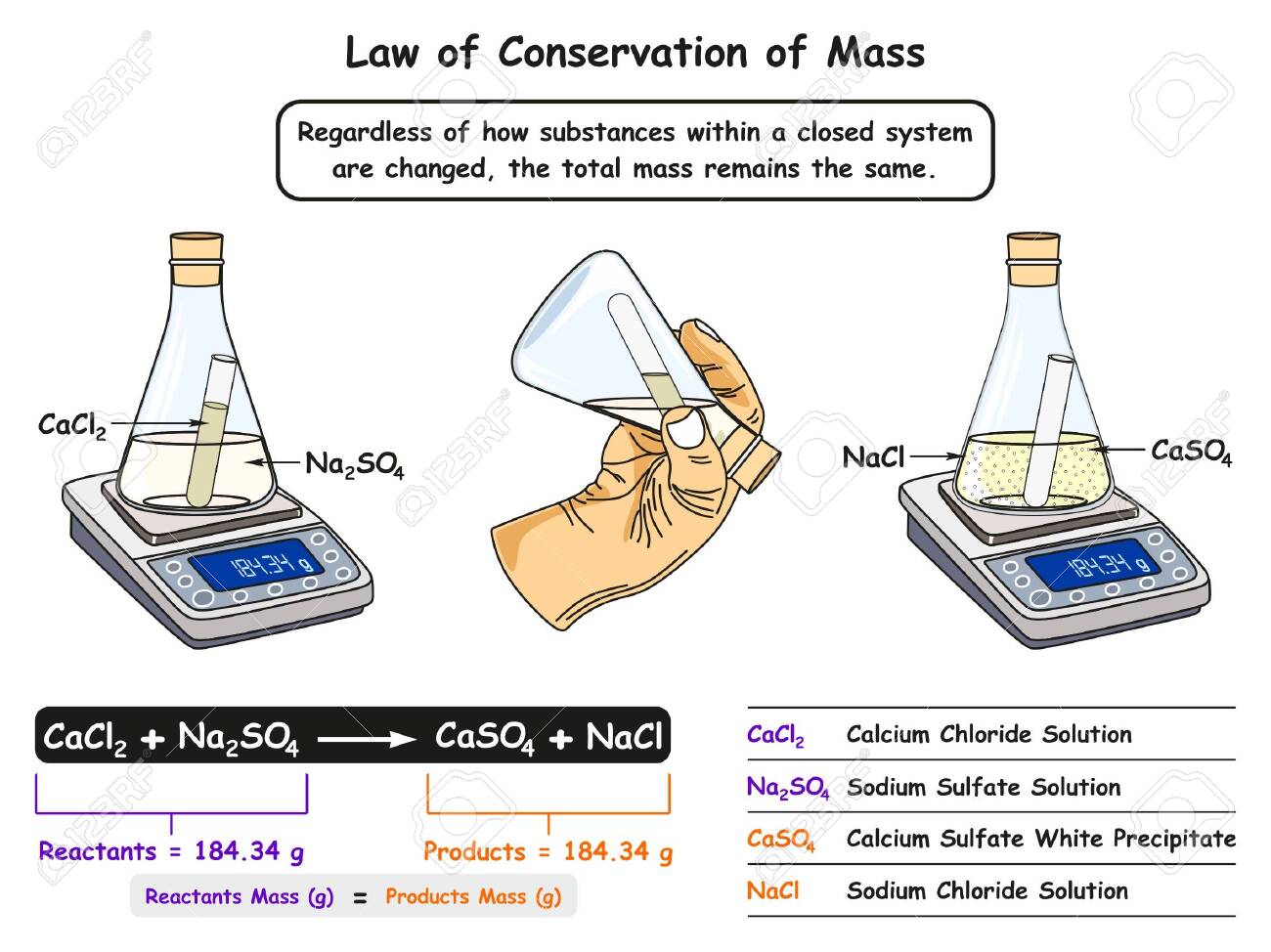
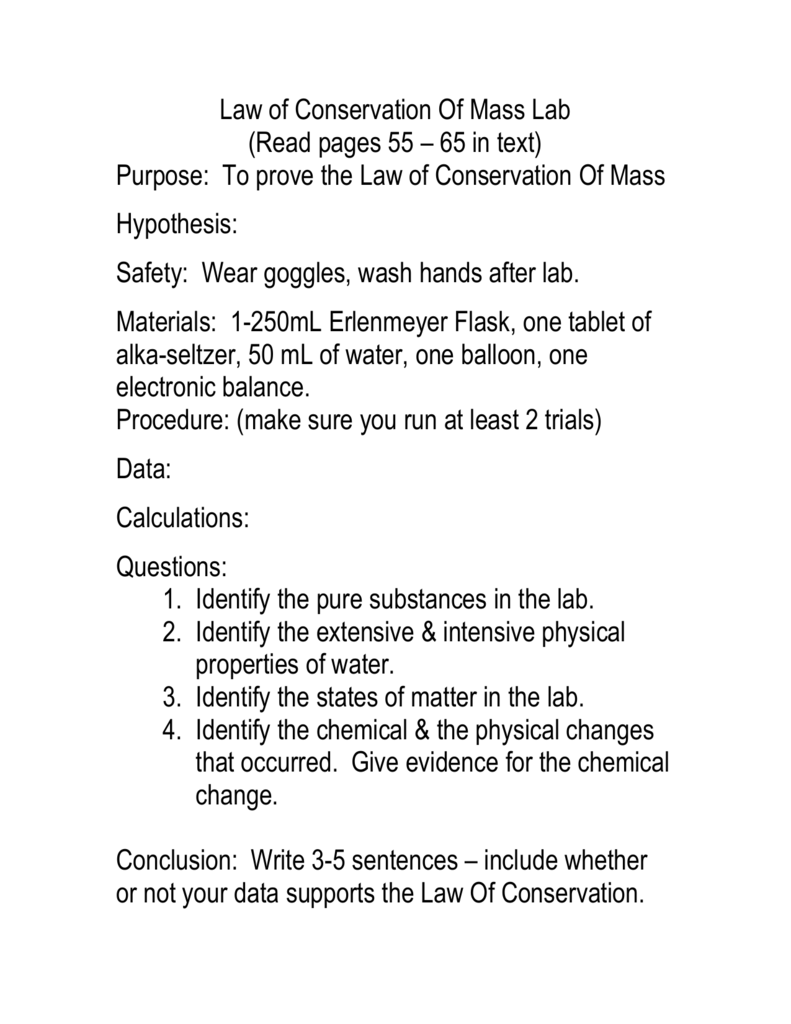

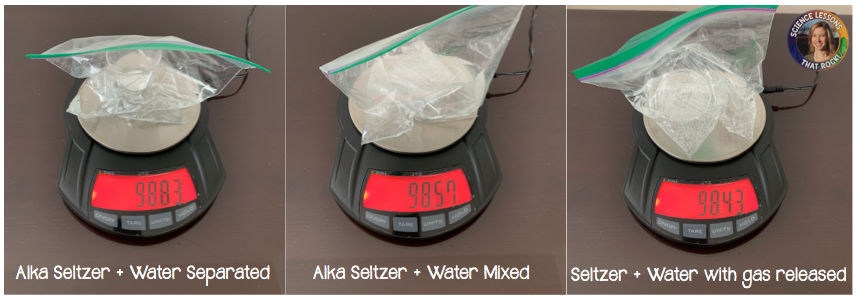


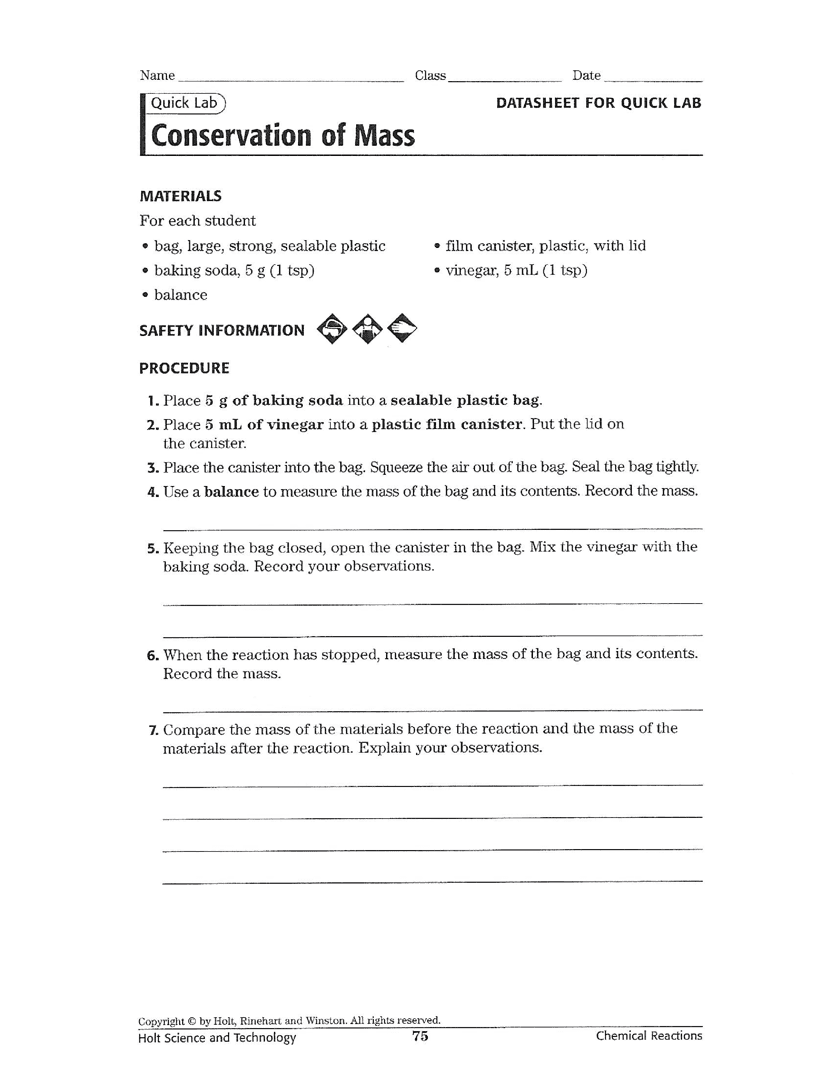





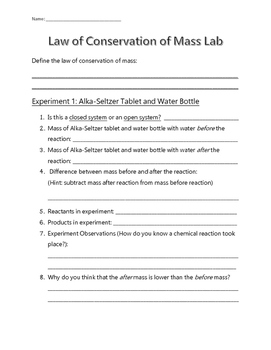








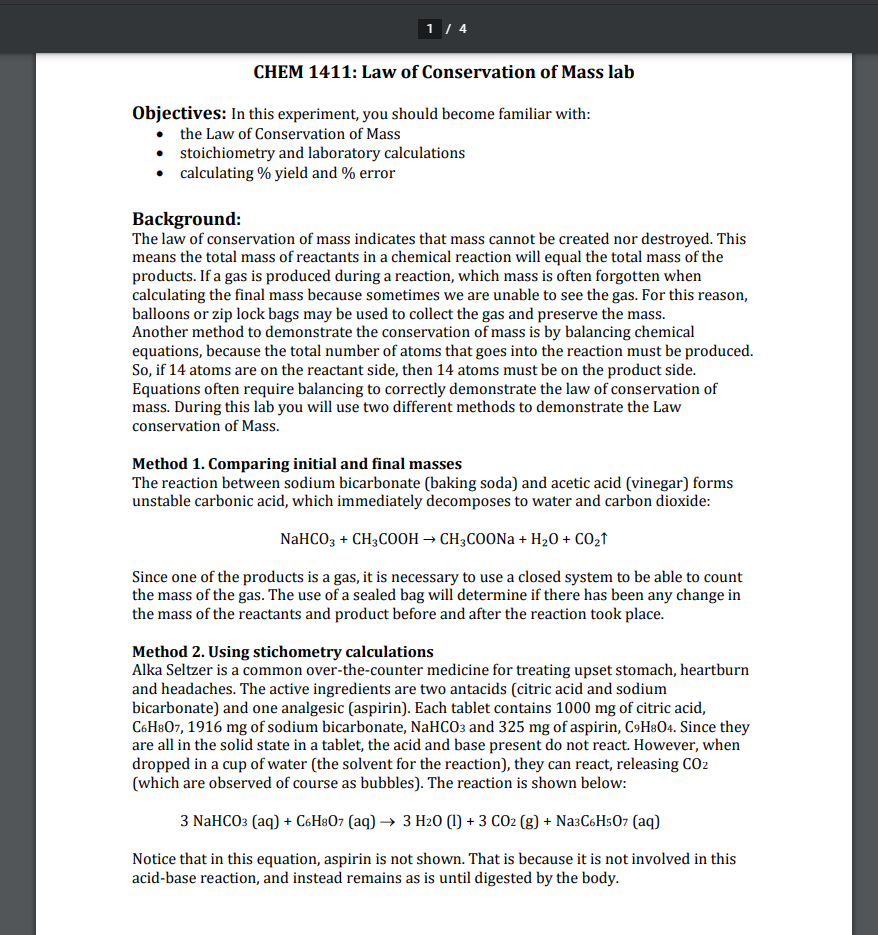
0 Response to "39 conservation of mass lab"
Post a Comment